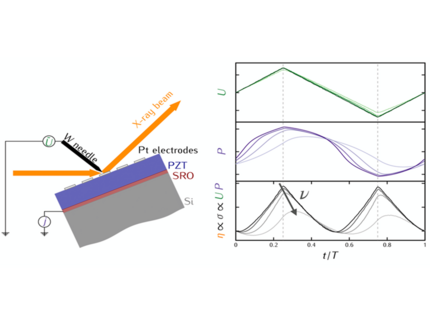Ferroelectric switching
We have recently developed the possibility to simultaneously probe the electrical and structural response of ferroelectric capacitors which are often closely coupled in such materials. Conventional positive-up-negative-down (PUND) sequences and other periodic elecrical pulse sequences drive the ferroelectric response of ferroelectric thin films while time-resolved x-ray diffraction (at synchrotrons) probes the structural changes (structure factor, strain, disorder and domain structure). We aim at driving ultrafast ferroelectric switching by heat and strain pulses and extend our investigations to ferroelectrics integrated on Si in collaboration with Catherine Dubourdieu (HZB & FU Berlin).
Related publications
C. Kwamen, M. Rössle, W. Leitenberger, P. Rojo Romeo, B. Vilquin, C. Dubourdieu, M. Bargheer
A Time-Domain Perspective on the Structural and Electronic Response in Epitaxial Ferroelectric Thin Films on Silicon
This operando study of epitaxial ferroelectric Pb(Zr0.48Ti0.52)O3 capacitors on silicon substrates studies their structural response via synchrotron-based time-resolved X-ray diffraction during hysteresis-loop measurements in the 2–200 kHz range. At high frequencies, the polarization hysteresis loop is rounded and the classical butterfly-like strain hysteresis acquires a flat dumbbell shape. We explain these observations from a time-domain perspective: The polarization and structural motion within the unit cell are coupled to the strain by the piezoelectric effect and limited by domain wall velocity. The solution of this coupled oscillator system is derived experimentally from the simultaneously measured electronic and structural data. The driving stress σFE(t) is calculated as the product of the measured voltage U(t) and polarization P(t). Unlike the electrical variables, σFE(t) and η(t) of the ferroelectric oscillate at twice the frequency of the applied electrical field. We model the measured frequency-dependent phase shift between η(t) and σFE(t).
Rössle M., Thomas O., Mocuta C., Rousset R., Texier M., Escoubas S., Dubourdieu C., Araújo E. B., and Cornelius T. W.
Time-resolved piezoelectric response in relaxor ferroelectric (Pb0.88La0.12)(Zr0.52Ti0.48)O3 thin films
Journal of Applied Physics 131, 064102 (2022).
The domain switching dynamics in a relaxor ferroelectric lanthanum-modified lead zirconate titanate thin film with 12 mol. % La was investigated by time-resolved x-ray diffraction. While most frequently epitaxial thin films are investigated, the present work reports results on a polycrystalline thin film. Asymmetric butterfly loops of the strain as a function of the applied electric field evidenced a built-in electric field oriented toward the thin film–substrate interface. The piezoelectric coefficient d33 (in the film reference frame) diminishes with the increasing frequency of an applied AC electric field. From the strain transient during the application of positive-up negative-down voltage pulse sequences with frequencies of up to 100 kHz, characteristic times of the order of 100–200 ns were determined for these relaxor ferroelectric thin films. While switching times ranging from the picosecond to the millisecond range are reported in the literature for different materials, these characteristic switching times are comparable to epitaxial lead zirconate titanate thin films of various compositions despite the polycrystallinity of the present thin film. However, the evidenced built-in electric field significantly influences the switching behavior for different polarities.
Rössle M., Leitenberger W., Reinhardt M., Koç A., Pudell J.-E., Kwamen C., and Bargheer M.
The time-resolved hard X-ray diffraction endstation KMC-3 XPP at BESSY II
Journal of Synchrotron Radiation 28, 1 (2021).
The time-resolved hard X-ray diffraction endstation KMC-3 XPP for optical pump/X-ray probe experiments at the electron storage ring BESSY II is dedicated to investigating the structural response of thin film samples and heterostructures after their excitation with ultrashort laser pulses and/or electric field pulses. It enables experiments with access to symmetric and asymmetric Bragg reflections via a four-circle diffractometer and it is possible to keep the sample in high vacuum and vary the sample temperature between ∼15 K and 350 K. The femtosecond laser system permanently installed at the beamline allows for optical excitation of the sample at 1028 nm. A non-linear optical setup enables the sample excitation also at 514 nm and 343 nm. A time-resolution of 17 ps is achieved with the `low-α' operation mode of the storage ring and an electronic variation of the delay between optical pump and hard X-ray probe pulse conveniently accesses picosecond to microsecond timescales. Direct time-resolved detection of the diffracted hard X-ray synchrotron pulses use a gated area pixel detector or a fast point detector in single photon counting mode. The range of experiments that are reliably conducted at the endstation and that detect structural dynamics of samples excited by laser pulses or electric fields are presented.
Kwamen C., Rössle M., Leitenberger W., Alexe M., and Bargheer M.
Time-resolved X-ray diffraction study of the structural dynamics in an epitaxial ferroelectric thin Pb(Zr0.2Ti0.8)O3 film induced by sub-coercive fields
Applied Physics Letters 114, 162907 (2019).
The electric field-dependence of structural dynamics in a tetragonal ferroelectric lead zirconate titanate thin film is investigated under subcoercive and above-coercive fields using time-resolved X-ray diffraction. The domain nucleation and growth are monitored in real time during the application of an external field to the prepoled thin film capacitor. We propose the observed broadening of the in-plane peak width of the symmetric 002 Bragg reflection as an indicator of the domain disorder and discuss the processes that change the measured peak intensity. Subcoercive field switching results in remnant disordered domain configurations.
Kwamen C., Rössle M., Reinhardt M., Leitenberger W., Zamponi F., Alexe M., and Bargheer M.
Simultaneous dynamic characterization of charge and structural motion during ferroelectric switching
Physical Review B 96, 134105 (2017).
Schick D., Bojahr A., Herzog M., Gaal P., Vrejoiu I., and Bargheer M.
Following Strain-Induced Mosaicity Changes of Ferroelectric Thin Films by Ultrafast Reciprocal Space Mapping
Physical Review Letters 110, 095502 (2013).
C. von Korff Schmising, M. Bargheer, M. Kiel, N. Zhavoronkov, M. Woerner, T. Elsaesser, I. Vrejoiu, D. Hesse and M. Alexe
Coupled Ultrafast Lattice and Polarization Dynamics in Ferroelectric Nanolayers
2007, Phys. Rev. Lett., 98, 25, 257601





